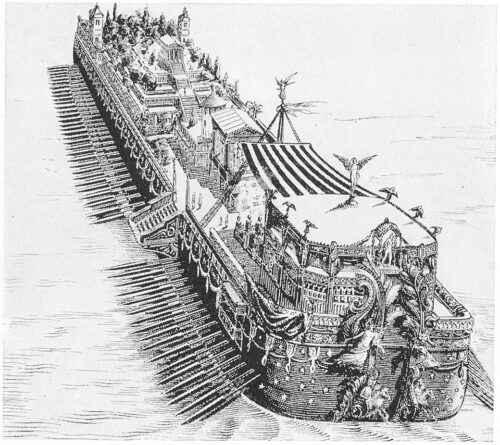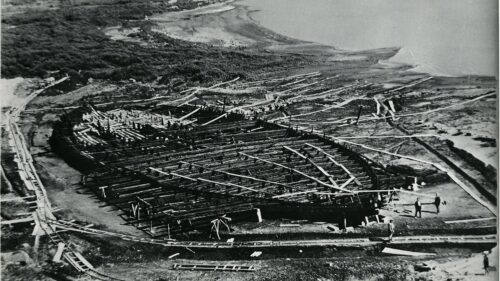Caligula was the third Roman Emperor , ruling from AD 37 to 41. He was Emperor for only four years, but his name has lived on in history due to a penchant for sadism, hedonistic excess and brutality. He demanded to be worshipped as a living God, and had the expensive tastes to match. Records show that he emptied the Imperial treasury in a single year with extravagant games and spectacles. Part of these money were spent to build two huge vessels, incredibly decorated, to be placed in a small lake few miles south of Rome, close to a sacred area dedicated to the goddess Diana, a fitting place for a living divinity to site his pleasure barges.
The largest vessel, dubbed the “prima nave” (first ship) was enormous, steered with oars 36 feet long. The second was a giant floating platform replete with marble palaces, gardens, and a system of plumbing for baths. Roman historian Seutonius described the sight of the ships: “Ten banks of oars… the poops of which blazed with jewels… filled with ample baths, galleries, and saloons, and supplied with a great variety of vines and fruit trees.”
On these ships, Caligula was reported to hold parties where his wild and licentious appetites ran wild, with later historians repeating scurrilous and outlandish rumours about relationships with the wives of his generals and senators, and even with his own sisters.

Despite their expense, these opulent palaces were afloat for only the briefest time. It seems they were only in use for about a year before Caligula’s four year reign came to an end. An alliance of senators and the Praetorian Guard ambushed him in a tunnel beneath Rome’s Capitoline Hill and stabbed him to death. Caligula’s floating palaces, too, went the way of their creator. Their hulls pierced, the immense ships were weighted with stones and sunk to the lake bottom.
For centuries, the medieval fishermen who sailed in the placid waters of Lake Nemi, knew a secret. It was said that the rotting timbers of a gigantic ancient shipwreck lurked below the water’s quiet surface. But the lake was tiny, with an area of only 0.6 square miles. And with no other body of water connected to it, what could a vessel of that size be doing there? Still, the stories about the gigantic ship persisted.
Looking at the placid waters of Lake Nemi in the 15th century, none of that would have seemed plausible. But for years now, fishermen had been using grappling hooks to bring up ancient artifacts from the legendary wreck that lay beneath, and selling them in the markets.
In 1446, a young Cardinal decided to probe for himself the rumours of an unlikely shipwreck at the bottom of Lake Nemi. He sailed out onto the lake, and sure enough, he could just make out a sprawling lattice of wooden beams. He and his men tried to send down ropes with hooks on the end to retrieve parts of this mysterious structure, but at a depth of 60 feet they didn’t have much luck. All they managed was to tear off some planks. Colonna had confirmed that the wreck existed, but from there the mystery only deepened.
In 1535, Italian inventor Guglielmo de Lorena and his partner Francesco de Marchi returned to the wrecks with a new and exciting technology: a diving bell. They descended through the murk and gloom and saw an enormous wooden superstructure far vaster than anything they had imagined. The two fished around in the lake bottom for artifacts, and managed to bring up sculptures made of marble and bronze scattered on the muddy lake bottom. Many others tried to explore and survey the wrecks, but without much success. It wasn’t until Italy fell under the sway of the fascist dictator Benito Mussolini that the ships would finally be uncovered.
Mussolini was a man obsessed with the legacy of Imperial Rome, and he worked hard to include its archaeological remains in his cult of personality.He excaveted the area around the Mausoluem of Emperor Augustus and around the Theatre of Marcellus, and digging up the floor of the Colosseum’s Arena to expose the hypogeum beneath and stripping it of its once verdant plant life. He was frequently described in propaganda dispatches as “a new Augustus”, evoking the Roman Emperor who rebuilt much of the city during his reign.
In 1929, Mussolini ordered something unprecedented. The whole of Lake Nemi would be drained. Engineers reactivated an ancient Roman cistern that together with a modern pump reduced the lake’s water level by 65 feet. In the mud, slowly emerging from the waters, the Italian engineers found not one, but two enormous shipwrecks. The excavations would take years, with the second ship not brought up until 1932.

The ships were vast, among the largest ever recovered from the ancient world. The largest was 240 feet in length, the same length as an Airbus A380, and measured 79 feet across. From inscriptions on lead pipes and tiles, it soon became clear that what had been discovered were the floating pleasure palaces of the infamous first century Roman Emperor Caligula.
While excavating at Lake Nemi, Italian archaeologists uncovered a veritable treasure trove of artifacts from the wrecks. Vast anchors, bronze mouldings and marble statues came up from the depths, along with ornamental oar rings and joints in copper and bronze. They found carvings and mosaics, even gilded copper roof tiles that would have shone spectacularly in the sun. The expense of the vessels would have been enormous.
After bringing back to light the two wrecks, Mussolini had a huge museum built in 1936 to house the wrecks, so that the public could visit. But Mussolini, like Caligula, would soon face a fitting downfall. And the Nemi ships would follow him into the ashes of history. In fact in the night of May 31 1944, the Nemi ships burned, probably thanks to a fire started by the Nazi army on its retreat.
Today, the ghosts of the Nemi ships live only in their photographs, and the few remaining artifacts that survived the fire.

Lake Nemi and the area of the Alban Hills¹ is few miles south of Rome and we love to organize pleasant walks in the parks and characteristic little towns. Ask us to customize your tour during your visit to Rome and you will discover some incredible gems away from the most crowded and famous spots of Rome.
To costumize you tour click HERE

